Benutzer-Werkzeuge
Chamaecyparis obtusa (Siebold & Zucc.) Endl. - syn.Cupressus obtusa K. Koch; Retinispora obtusa Siebold & Zucc. - Cupressaceae
檜 or 桧, hinoki (Jap.), Japanese cypress, hinoki, Hinoki-Scheinzypresse
Evergreen tree, up to 40m tall, native to Japan and Taiwan, naturalized and cultivated elsewhere as ornamental and for timber; bark light reddish brown, peeling off in thin strips; crown narrowly pyramidal; branches drooping to pendulous; cones reddish, globose, small, about 5-10 mm in diameter; cone scales peltate.
http://www.efloras.org/florataxon.aspx?flora_id=2&taxon_id=200005410
https://facultystaff.richmond.edu/~jhayden/conifers/chamaecyparis.html (pictures)
Main components of the essential oil from the leaves of C.obtusa were elemol (14.7%), α-terpinyl acetate (9.0%), bornyl acetate (7.1%), γ-eudesmol (8.2%), β-eudesmol (6.5%), α-eudesmol (5.3%), and γ-muurolene (5.7%).
Main components of the essential oil from the wood of C.obtusa were α-cadinol (20.5%), τ-muurolol (18.5%), γ-cadinene (12.4%), δ-cadinene (10.8%), and τ-cadinol (10.6%).
[Monoterpenoid and Sesquiterpenoid Constituents of the Essential Oil of Hinoki (Chamaecyparis obtusa (Sieb. et Zucc.) Endl.)., Shieh, B., Iizuka, Y., Matsubara, Y., Agricultural and Biological Chemistry, 45(6), 1981, 1497-1499] http://www.tandfonline.com/doi/pdf/10.1080/00021369.1981.10864734
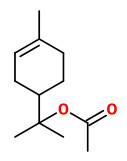 α-terpinyl acetate (herbal sweet) | 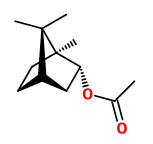 bornyl acetate (sweet herbaceous-piney) | 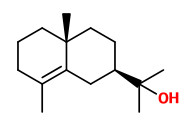 γ-eudesmol (waxy sweet) | 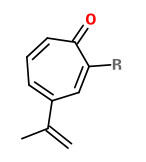 β-thujaplicin, R=OH (woody-phenolic) |
Hinokitiol (thujaplicin), was not found in the neutral wood oil of C.obtusa. Yoshixol (4,4-dimethyl-6-methylene-2-cyclohexen-1-one) was regarded as major constituent the neutral wood oil. Yoshixol showed strong antibiotic effects on MRSA, Escherichia coli, Mycobacterium chelonei, Pseudomonas aureginosa and Candida albicans.
[A new substance (Yoshixol) with an interesting antibiotic mechanism from wood oil of Japanese traditional tree (Kiso-Hinoki), Chamaecyparis obtusa., Koyama, S., Yamaguchi, Y., Tanaka, S., Motoyoshiya, J., General Pharmacology: The Vascular System, 28(5), 1997, 797-804]
The acaricidal activity of C.obtusa leaves against Dermatophagoides farinae and Dermatophagoides pteronyssinus likely results from β-thujaplicin. „The active constituent of the C. obtusa leaves was identified as β-thujaplicin (C10H12O2) by spectroscopic analyses…. On the basis of a 24 h LC50 value, acaricidal activity against D. farinae was more pronounced with β-thujaplicin (72.2 mg/m2) than benzyl benzoate (89.9 mg/m2) and DEET (377 mg/m2). Acaricidal activity against D. pteronyssinus was more pronounced in β-thujaplicin (62.1 mg/m2) than benzyl benzoate (72.4 mg/m2) and DEET (193 mg/m2).“
[Acaricidal activity of active constituent isolated in Chamaecyparis obtusa leaves against Dermatophagoides spp., Jang, Y.S., Lee, C.H., Kim, M.K., Kim, J.H., Lee, S.H., Lee, H.S., Journal of agricultural and food chemistry, 53(6), 2005, 1934-1937]
„… using hinoki wood-wool to produce tatami mats is an effective method of suppressing the activity of mites for about 1 year.“
[Effect of hinoki (Chamaecyparis obtusa) wood-wool in tatami mat on the activity of house dust mite Dermatophagoides pteronyssinus., Hiramatsu, Y., Matsui, N., Ohira, T., Imai, Y., Miyazaki, Y., Journal of wood science, 52(4), 2006, 353-357]
„Aromatic volatile substances (phytoncides) were produced by vaporizing Chamaecyparis obtusa (hinoki cypress) stem oil with a humidifier in the hotel room during the night stay. Blood samples were taken on the last day and urine samples were analysed every day during the stay. NK activity, the percentages of NK and T cells, and granulysin, perforin, granzyme A/B-expressing lymphocytes in blood, and the concentrations of adrenaline and noradrenaline in urine were measured. Similar control measurements were made before the stay on a normal working day. The concentrations of phytoncides in the hotel room air were measured. Phytoncide exposure significantly increased NK activity and the percentages of NK, perforin, granulysin, and granzyme A/B-expressing cells, and significantly decreased the percentage of T cells, and the concentrations of adrenaline and noradrenaline in urine.“
[Li, Q., et al. „Effect of phytoncide from trees on human natural killer cell function.“ International journal of immunopathology and pharmacology 22.4 (2009): 951-959] http://journals.sagepub.com/doi/pdf/10.1177/039463200902200410
The essential oil of C.obtusa leaves contained α-terpinyl acetate (14.9%), sabinene (10.9%), limonene (9.6%), α-terpinolene (7.5%), α-pinene (7.1%), 3-carene (6.1%), terpinene-4-ol (5.7%), myrcene (4.9%), γ-terpinene (4.6%), bicyclosesquiphellandrene (4.1), γ-eudesmol (3.7%), widdrene (3.5%) and cedrol (3.1%).
[Jung, J. Y., & Choi, M. S. 국내산 침엽수 추출물의 Trichoderma spp. 에 대한항균활성. Journal of Agriculture & Life Science, 45(4), 2011, 1-11]
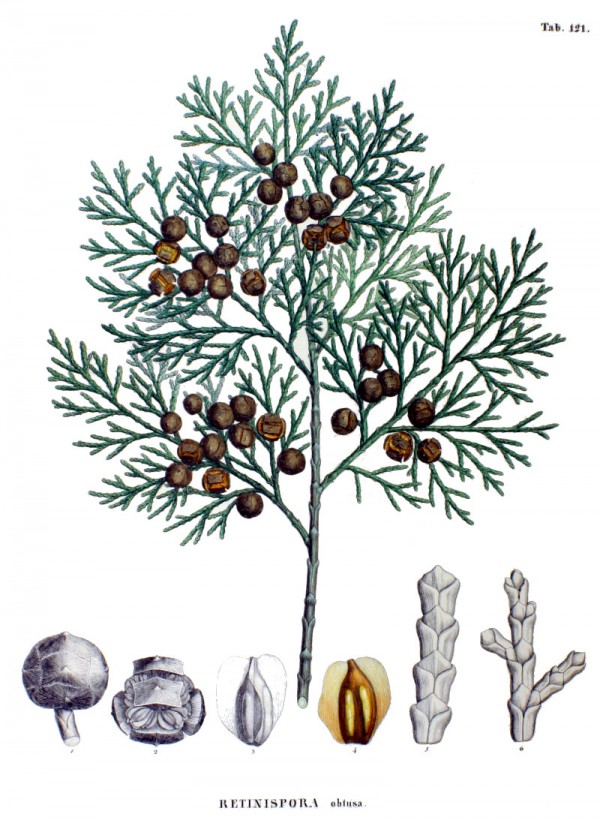
Siebold,P.F. von, Zuccarini,J.G., Flora Japonica, t.121 (1875)
http://plantgenera.org/species.php?id_species=230171
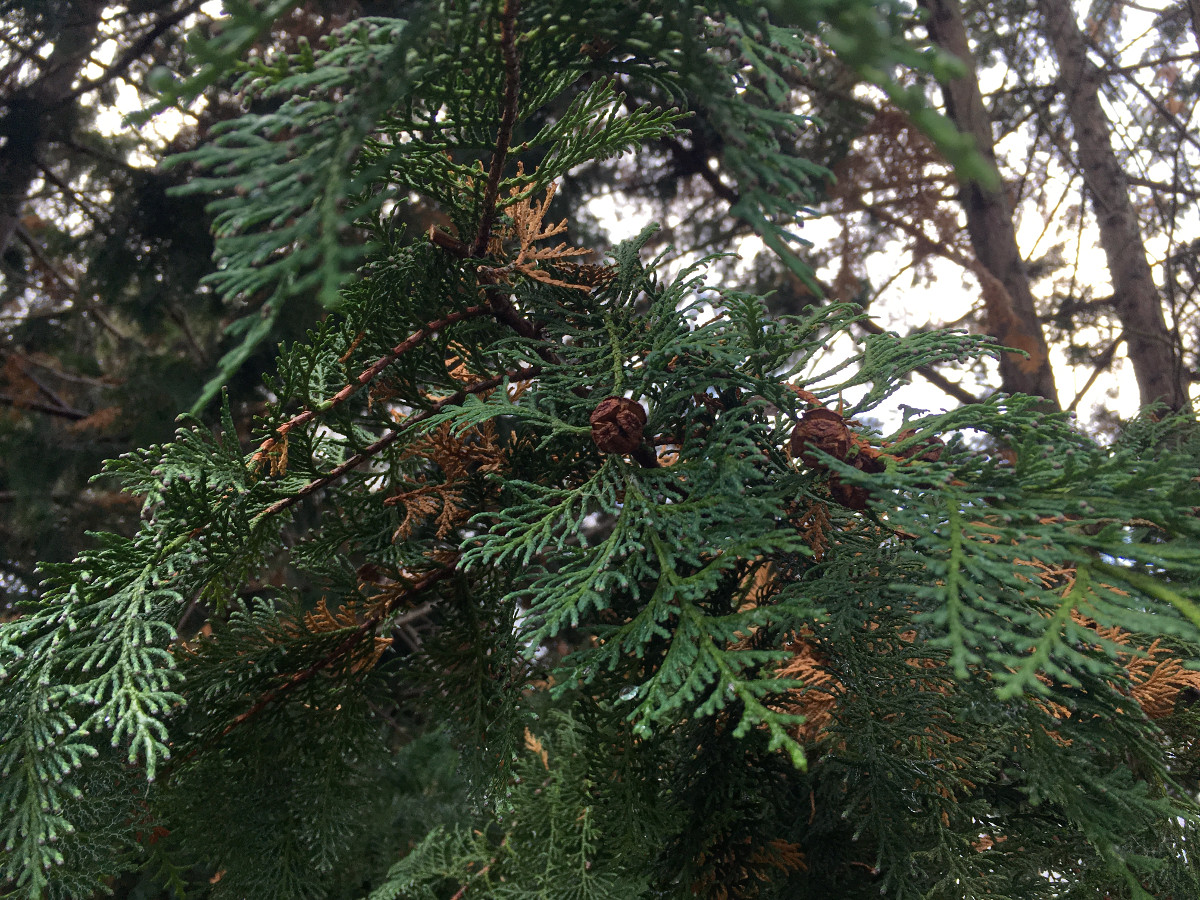
Chamaecyparis obtusa, Author: Andreas Kraska CC BY-SA 3.0
